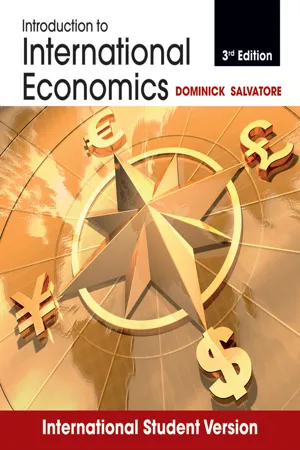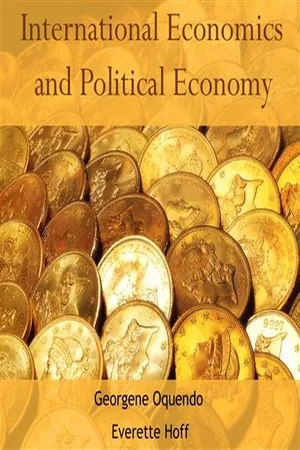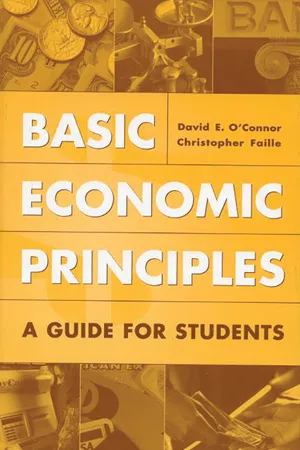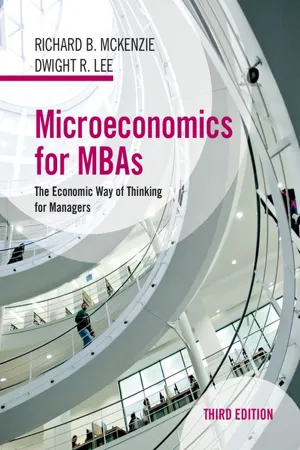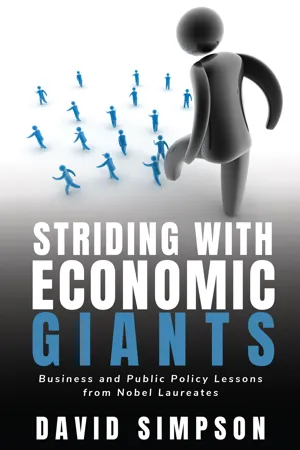Economics
Basics of International Economics
The basics of international economics encompass the study of how countries interact through trade, finance, and investment. Key concepts include comparative advantage, exchange rates, balance of payments, and trade policies. International economics seeks to understand the impact of globalization on national economies and the implications for economic growth, income distribution, and overall welfare.
Written by Perlego with AI-assistance
Related key terms
1 of 5
7 Key excerpts on "Basics of International Economics"
- eBook - PDF
- Dominick Salvatore(Author)
- 2012(Publication Date)
- Wiley(Publisher)
The United States is simply spending too much and living beyond its means—a situation that the United States needs to correct. Chapter One Introduction to the Global Economy 13 1.5 THE SUBJECT MATTER OF INTERNATIONAL ECONOMICS International economics deals with the economic and financial interdepen- dence among nations. It analyzes the flow of goods, services, payments, monies, and people between a nation and the rest of the world, the policies directed at regulating these flows, and their effect on the nation’s welfare. This economic and financial interdependence is affected by, and in turn influences, the political, social, cultural, and military relations among nations. Balance of pay- ments A summary statement of all the international transac- tions of the residents of a nation with the rest of the world during a particu- lar period of time, usually a year. Specifically, international economics deals with international trade theory, international trade policy, the balance of payments and foreign exchange markets, and open-economy macroeconomics. International trade theory analyzes the basis for and the gains from trade. International trade policy examines the reasons for and the effects of trade restrictions. The balance of payments measures a nation’s total receipts from and the total Foreign exchange markets The framework for the exchange of one national currency for another. payments to the rest of the world, while foreign exchange markets is the institutional framework for the exchange of one national currency for others. Finally, open-economy macroeconomics deals with the mechanisms of adjustment in the balance of payments disequilibria (deficits and surpluses). More importantly, it analyzes the relationship between the internal and the external sectors of the economy of a nation, and how they are interrelated or Adjustment in the balance of pay- ments The opera- tion and effects of the mechanisms for correcting balance- of-payments disequi- libria. - eBook - PDF
- Dominick Salvatore(Author)
- 2014(Publication Date)
- Wiley(Publisher)
The United States is simply spending too much and living beyond its means—a situation that the United States needs to correct. Chapter One Introduction to the Global Economy 11 1.5 THE SUBJECT MATTER OF INTERNATIONAL ECONOMICS International economics deals with the economic and financial interdepen- dence among nations. It analyzes the flow of goods, services, payments, monies, and people between a nation and the rest of the world, the policies directed at regulating these flows, and their effect on the nation’s welfare. This economic and financial interdependence is affected by, and in turn influences, the political, social, cultural, and military relations among nations. Balance of pay- ments A summary statement of all the international transac- tions of the residents of a nation with the rest of the world during a particu- lar period of time, usually a year. Specifically, international economics deals with international trade theory, international trade policy, the balance of payments and foreign exchange markets, and open-economy macroeconomics. International trade theory analyzes the basis for and the gains from trade. International trade policy examines the reasons for and the effects of trade restrictions. The balance of payments measures a nation’s total receipts from and the total Foreign exchange markets The framework for the exchange of one national currency for another. payments to the rest of the world, while foreign exchange markets is the institutional framework for the exchange of one national currency for others. Finally, open-economy macroeconomics deals with the mechanisms of adjustment in the balance of payments disequilibria (deficits and surpluses). More importantly, it analyzes the relationship between the internal and the external sectors of the economy of a nation, and how they are interrelated or Adjustment in the balance of pay- ments The opera- tion and effects of the mechanisms for correcting balance- of-payments disequi- libria. - No longer available |Learn more
- (Author)
- 2014(Publication Date)
- College Publishing House(Publisher)
____________________ WORLD TECHNOLOGIES ____________________ Chapter- 1 Introduction to International Economics International economics is concerned with the effects upon economic activity of international differences in productive resources and consumer preferences and the institutions that affect them. It seeks to explain the patterns and consequences of transactions and interactions between the inhabitants of different countries, including trade, investment and migration. • International trade studies goods-and-services flows across international boundaries from supply-and-demand factors, economic integration, and policy variables such as tariff rates and trade quotas. • International finance studies the flow of capital across international financial markets, and the effects of these movements on exchange rates. • International monetary economics and macroeconomics studies money and macro flows across countries. International trade Scope and methodology The economic theory of international trade differs from the remainder of economic theory mainly because of the comparatively limited international mobility of the capital and labour . In that respect, it would appear to differ in degree rather than in principle from the trade between remote regions in one country. Thus the methodology of international trade economics differs little from that of the remainder of economics. However, the direction of academic research on the subject has been influenced by the fact that governments have often sought to impose restrictions upon international trade, and the motive for the development of trade theory has often been a wish to determine the consequences of such restrictions. - eBook - ePub
- Harlan M. Smith(Author)
- 2016(Publication Date)
- Routledge(Publisher)
The International Economy32 International Economic Relations
Recently there has been more attention to the importance of international economic relations. To study them, students need background in both micro and macro; but when the topic is put at the end of the book, instructors may fail to get that far in the course. There is a problem in any case if the books don’t provide enough tie to the real international relations issues that are not just a matter of the theory of comparative advantage. One may get a discussion of protectionism as against free trade principles, but one may get little if any indication of the respects in which the cold war distorted international trade and investment, little if anything on the background of and nature of the third world demands for a New International Economic Order, little if anything on the conflict over the Common Agricultural Policy of the European Economic Community, little on the complex factors in the U.S. quarrel with Japan, and little on the complex sets of factors leading to the breakdown first of the gold standard and then of the Bretton Woods System. Having any real understanding of international economic relations is simply not reducible merely to understanding the principle of comparative advantage and the present nonsystem in international exchange rate determination.As for comparative advantage, despite efforts to distinguish it from absolute advantage, students typically do not learn why trade would pay even if a country was in some sense more efficient in every line of production than competitors, or how a country could still trade profitably even if it was less efficient in every line than any foreign country. The clue, of course, is that the degree of a country’s superiority or inferiority in different lines would not be, indeed could not be, exactly the same; hence it would pay to specialize in producing and exporting those things in which its advantage was greatest or its disadvantage least. - eBook - PDF
Basic Economic Principles
A Guide for Students
- David E. O'Connor, Christophe Faille(Authors)
- 2000(Publication Date)
- Greenwood(Publisher)
The guide is also comprehensive in that it introduces and applies the 21 basic economic concepts outlined in A Framework for Teaching Basic Economic Concepts (Economics America, 1995). Basic Economic Principles is a convenient guide to the economy and how it works. The 15 essential questions provide a content focus for each Page viii chapter. Each chapter is also subdivided into sections and subsections to help pinpoint information. For the reader’s convenience an extensive Glossary of Economic Terms appears at the end of the guide. In addition, as key terms are woven into each chapter, they appear in boldfaced print. Thus, the design of Basic Economic Principles motivates students, teachers, and other citizens to consider key economic questions, and then provides a “userfriendly” format to locate timely, relevant information needed for their responses. Economics sometimes has been called a “dismal science.” But nothing could be further from the truth. Economics is an essential part of our everyday lives. It deals with every production and consumption decision that we make—how to produce goods, how to spend our limited incomes, how to invest our money, and how to meet our personal, business, and national economic goals. And while there will inevitably be debate and disagreement about the decisions people make, there is one certainty— that the decisions we make today will shape our standard of living in the future. Page 1 1 WHAT IS ECONOMICS? Chapter 1 examines economics as a field of study. Because economics is a social science, it deals with human relations and the behaviors of people in the economy. Scarcity is identified as the universal economic problem, a problem that requires people to make choices. This chapter stresses the importance of economics to the decisions that you make every day. It explains the need for a scientific approach to problem solving and the value of reading and thinking critically. - eBook - PDF
Microeconomics for MBAs
The Economic Way of Thinking for Managers
- Richard B. McKenzie, Dwight R. Lee(Authors)
- 2016(Publication Date)
- Cambridge University Press(Publisher)
In Part A of this chapter, we consider the economics of international trade, reviewing the law of comparative advantage first introduced briefly in Chapter 1 . In Part B , we take up international finance, which focuses on how the exchange values of currencies are determined, with the market forces of supply and demand prominently at play in that discussion. Applications of the economic way of thinking: international economics 203 A Part A International trade theory and public policy applications A discussion of international economics has two major divisions: (1) the actual move-ment of real goods and services across national boundaries that comes with trade, and (2) the financial considerations involved in multinational trade. We follow those discus-sions with a separate section on environmental economics in Chapter 6 . Global economics: international trade The term “international trade” can be misleading in capturing the nature of the growing volume of exchanges across national boundaries. Nations never really trade; people do. Although we might discuss trade in terms of nations as a matter of convenience, we are talking about trades that are negotiated by real people (or their firms), and certainly not by countries as some sort of amorphous whole. This simple point – that people are at the heart of cross-country exchanges – is important because it allows us to approach international trade as an extension of supply-and-demand and other trading models – indeed, the economic way of thinking in general. Understanding that trade is between people, not nations, is important for another reason. If we focus solely on aggregate gains from trade to nations taken as unified political entities, we may overlook the distributional effects of international commerce – the gains and losses to individuals (whether they act as independent contractors or as managers and owners of multinational firms). - eBook - ePub
Striding With Economic Giants
Business and Public Policy Lessons from Nobel Laureates
- David Simpson(Author)
- 2023(Publication Date)
- Business Expert Press(Publisher)
CHAPTER 9 International EconomicsIn the last chapter, we looked at how developing nations transition to developed ones. One feature in the previous few decades has been the explosion of globalization. This chapter looks at both types of countries and how they interact globally. It discusses global trade, international finance, and world public policy.Global TradeNations exchange goods, services, and capital in international trade. Trading globally exposes consumers and countries to goods and services unavailable or more expensive domestically. This section analyzes trade models, focuses on factor movement, and weighs in on interregional activities.Trade ModelsEconomists construct trade models to illustrate how international trade occurs in simple cases between two countries and a one-product market. First, they base the models on each country’s separate supply and demand functions. Next, the researchers identify domestic equilibrium prices and quantities for a given product market in these two countries. Finally, differences between domestic prices play a role in determining the direction of trade flow. In this topic, our laureates present their trade models. It describes the dynamics of these models and forms helpful conclusions.Interregional Trade ConditionsBertil Ohlin (1933), a Swedish economist and politician, developed a theory of international trade in harmony with the mutual-interdependence pricing theory. His approach falls outside the classical labor theory of value. Moreover, he demonstrates that international trade theory is only one part of the general location theory. General location theory considers the geographic aspects of pricing. Ohlin develops certain fundamentals of this location theory as background for international trade theory. He also examines local differences in the supply of factors of production within each country.Ohlin analyzes the movements of domestic and external production factors, particularly product activity. In addition, he explores the various mechanisms of international trade and global capital trends under conditions of fixed rates of foreign exchange. He stresses that understanding the geographical
Index pages curate the most relevant extracts from our library of academic textbooks. They’ve been created using an in-house natural language model (NLM), each adding context and meaning to key research topics.

